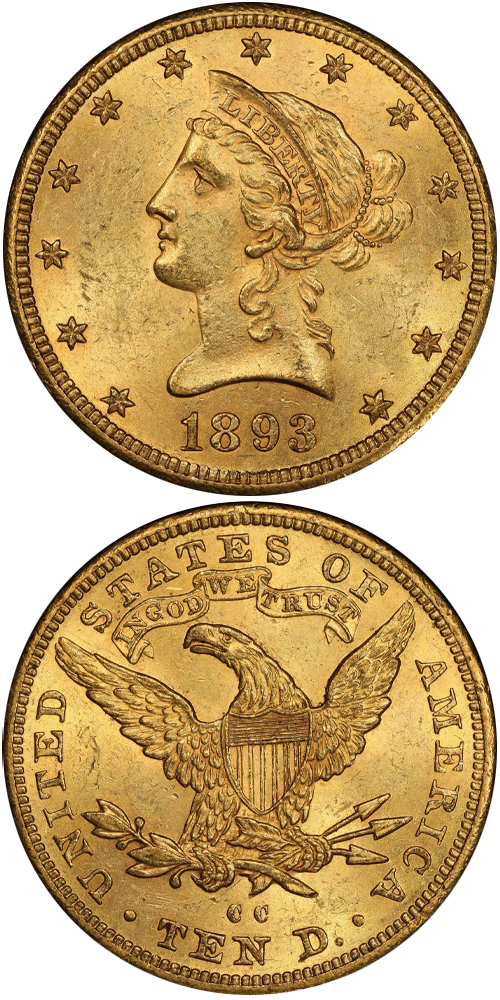1893-CC Liberty Head Eagle
Jeff Ambio: The date logotype for all known 1893-CC eagles is large, set low in the field, and slants down from left to right. The reverse exhibits a medium size, evenly spaced mintmark with both Cs level. The first C is over the left edge of the letter N in TEN and the second C is centered over the right upright of the letter N. Based on our observations, this reverse is not the same as Reverse A of the 1892-CC eagle, as reported in the 2001 book Gold Coins of the Carson City Mint by Douglas Winter and James L. Halperin. For one, the second C in the mintmark is a bit further to the right on the 1893-CC Winter 1-A variety than it is on both the Winter 1-A and Winter 2-A 1892-CC varieties.
Rusty Goe: When Grover Cleveland took office as the 24th president of the United States on March 4, 1893, the last thought on his mind was the status of the Carson City Mint. He whisked into office with a financial panic staring him front-on. The drain on the Treasury Department's gold reserves had ascended above alarm-mode to an all out state of emergency. The U.S. had exported over $100 million of gold coins, with no end in sight. The gold-coin supply in the country had plunged from a high of over $700 million to near the $500 million level, in just the last few years.
Cleveland forced through an emergency measure to repeal the 1890 Silver Purchase Act. The banks refused to redeem paper money. Foreign syndicates relentlessly continued to cash in all U.S. securities, demanding gold in exchange. Cleveland's new Treasury Secretary, John G. Carlisle, ordered the four working mints to increase their productions of gold half eagles and eagles.
By May, Cleveland, his Treasury secretary, and his mint director had taken time to assess the situation at the Carson City branch. They made the decision to close the coining department, reduce staff across the board, and place the mint in a holding pattern while the administration took care of more pressing concerns.
On June 8, 1893, Reno's Weekly Gazette and Stockman published excerpts of a story that had appeared in Salt Lake City's Tribune the day before. The Utah paper said the closing of the Carson Mint was proof that President Cleveland despised silver, that he believed "there is no call for that kind of money."
Coiner Colburn delivered 14,000 eagles in the early months of 1893, before he closed his department for good. From that final year's output of eagles, perhaps as many as three percent are extant (a favorite estimate to land on when it comes to Carson City eagles). The Battle Born example offered here is one of the finest known survivors of that date.
Q. David Bowers: From the final year of Carson City Mint production, Rusty Goe estimates 365 to 425 eagles exist totally, with 12 to 15 Uncirculated. My figures are somewhat lower. By any accounting, the Battle Born Collection example is very important. For some unexplained reason, VF is the typical grade of coins found in old-time collections (cf. Akers, 1980). EF and AU coins are quite scarce.
As the curtain came down on gold coin production in 1893, the total mintage of eagles at the Carson City Mint came to 299,778 pieces. In Philadelphia the figure was 12,123,186, and in San Francisco 5,308,350. New Orleans had occasional coinage totaling 97,693.
The example to the left was sold by Stack's Bowers Galleries in the Fairmont Collection, Hendricks Set, where it realized $84,000.






